Experience Inflatables
Inflatables that relate to the human body where beforehand one doesn't know exactly what will happen when they start to mingle
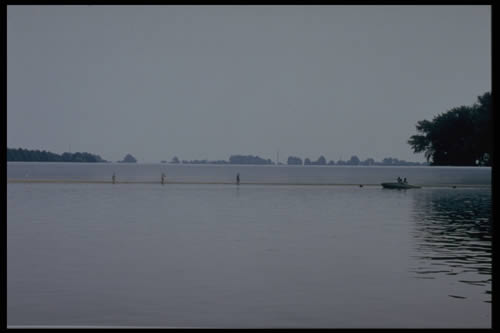
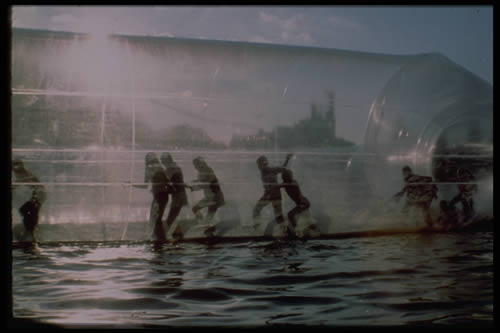
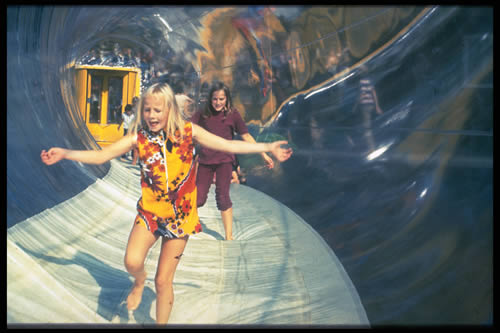
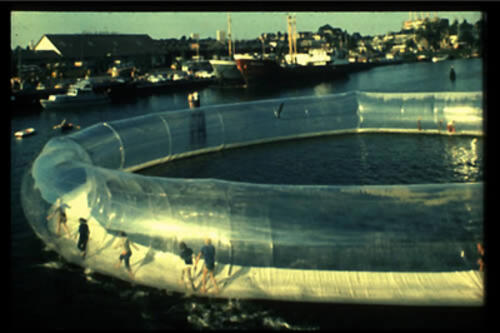
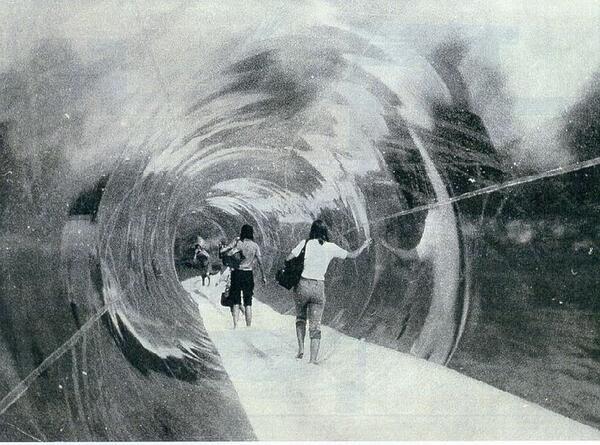
Waterwalk Tube: Theo Botschuiver & Jeffrey Shaw 1970. An inflatable tube made from transparent plastic, 250 metres long and 3 metres in diameter, was placed over the Masch lake connecting its opposite banks. This air-filled floating bridge had airlock revolving doors at each end, and its pliable floor was in direct contact with the water surface. Visitors were able to enter this almost immaterial structure and cross from one side of the lake to the other as if walking on water. In Groningen the tube was placed in a U-shape in the harbor in the front of the Central station (where the new Groningen Museum is now located).
source: http://www.jeffrey-shaw.net and spatialeffects.nl

The 1970 Hovertube Project – shown here as a quarter-mile-long prototype in Cornwall (1970)– allowed Graham Stevens to literally walk on water. and traverse land, water (and underwater) in his Hovertube (Pontube) project. Hovertube is an inflated transparent polythene tube, which allows you to literally walk on water, and deployed on land can bridge rough terrain with the aid of pneumatic integrity. This piece was captured as a part of the Atmosfields film, this human transportation tube would seem to have any number of practical applications as well as its sensory delights. Stevens had also seen the physicist Nikolaus Laing talk at the pneumatics colloquium and was interested in his work, which connected the two disciplines of air structures and solar energy. Stevens also cites Farrington Daniels’ influential book (recommended to him by Price) Direct Use of the Sun’s Energy (Yale University Press, 1964).http://jobs.thearchitecturalreview.org/2014/04/03/air-apparent-pneumatic-structures/
movie: http://ssa.nls.uk/film/T0829/74959364
http://ssa.nls.uk/film/T0829/74959364
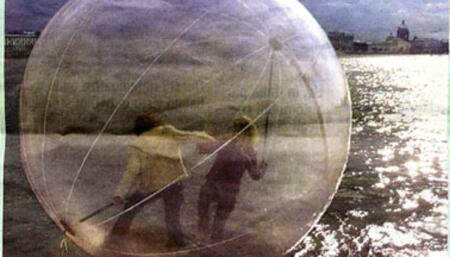
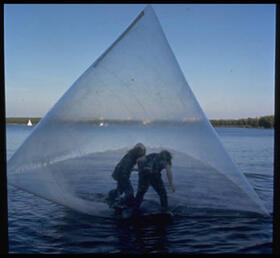
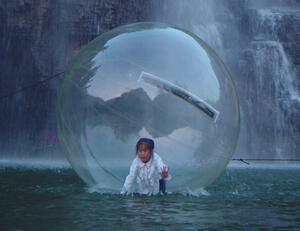
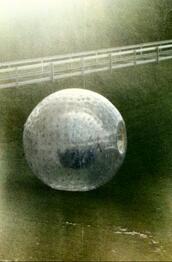
 \\
\\
Old and a new versions of the waterball
Theo Botschuiver, “Waterwalks”
Zorbs (invented by Theo Botschuyver) are now rolling all over the world: the zorb-speed record rolling downhill is 65km/hours
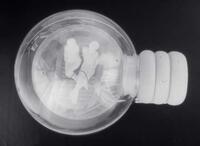
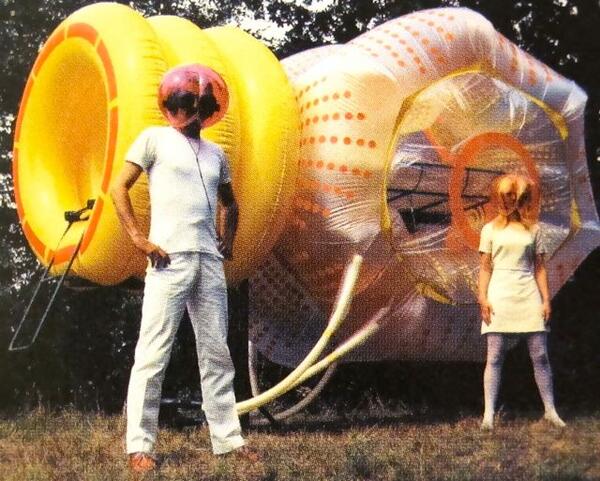
Yellow Heart: Haus-Rucker-Co, Viena, 1968
The idea that a concentrated experience of space could offer a direct approach to changes in consciousness led to the construction of a pneumatic space capsule, called the 'Yellow Heart'. Through a lock made of three air rings one arrived at a transparent plastic mattress. Offering just enough space for two people it projected into the centre of a spherical space that was made up of soft, air-filled chambers. Lying there one could perceive that the air-filled “pillows”, whose swelling sides almost touched one, slowly withdrew, that is to say the surrounding space appeared to expand, finally forming a translucent sphere and then, in a reverse motion, flowed out again. Large dots arranged in a grid on the outer and inner surfaces of the air-shells changed in rhythmic waves from milky patches to a clear pattern. The space pulsated at extended intervals.
Yellow hart is an inflatable device fusing architecture with the mechanics of the body (breathing) concerned with the possibility of achieving higher state of consciousness by means of concentrated spatial experience.
source: http://www.the-artists.org/Images/haus-rucker-co
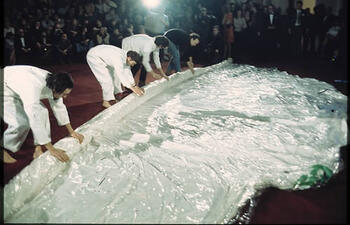
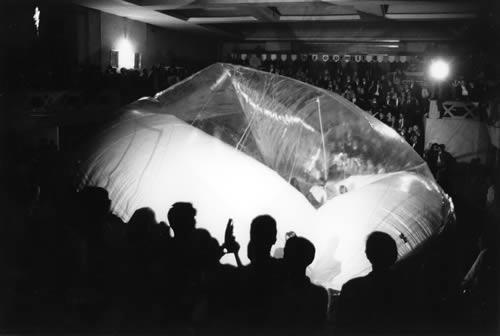
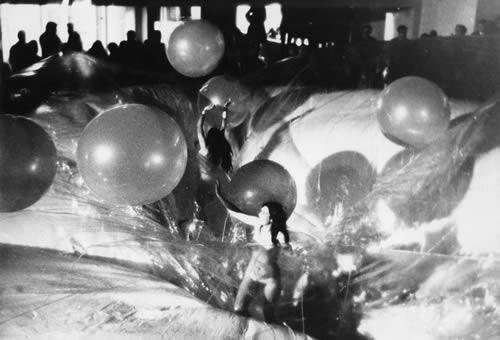
Movie Movie: Theo Botschuijver, Sean Wellesley-Miller, Tjebbe van Tijen & Jeffrey Shaw, 1967
While the inflatable structure was being gradually inflated, film, slides and liquid-light show effects were projected onto its surface. Its fully inflated shape was a 7m diameter and 10m high cone with an outer transparent membrane and an inner white surface. The projected imagery first impinged lightly on the outer envelope and then appeared on the semi-inflated inner surface; in the intermediate space various material actions were performed.
The intention of this work was to transmute the conventional flat cinema projection screen into a three dimensional kinetic and architectonic space of visualisation. The multiple projection surfaces allowed the images to materialise in many layers, and of the audience (many of whom spontaneously took off all their clothes) became part of the cinematic spectacle. In this way the immersive space of cinematic fiction included the literal and interactive immersion of the viewers who modulating the changing shapes of the pneumatic architecture which in turn modulated the shifting deformations of the projected imagery.With speakers placed both outside and inside the structure, its acoustic environment was also modulated in this way.
source: http://www.jeffrey-shaw.net
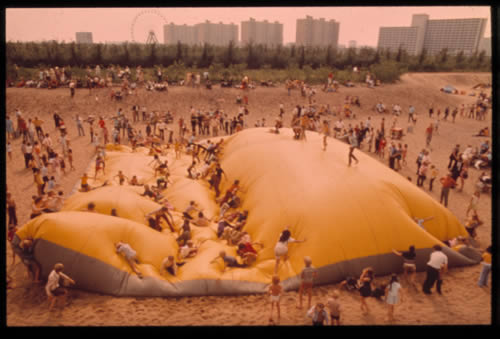
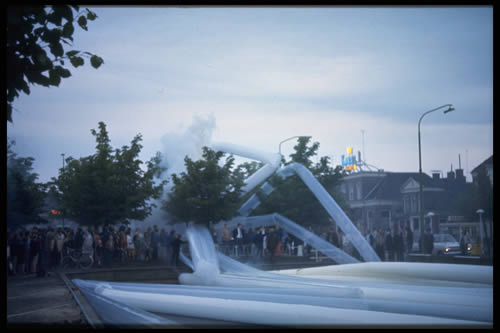
-Airground Mattress: 1968 Jeffrey Shaw & Theo Boschuiver,[aswell the inventor of the “jump cushion”]
source: http://www.jeffrey-shaw.net
-Waterquake: Theo Botschuiver & Jeffrey Shaw, 1970
In Waterquake long lengths of tubing were dropped into a canal and then slowly inflated with air and smoke. The tubing emerged from the water, filling the canal and then spilling over into the surrounding streets. The spectators pulled and knotted these tubes into various forms - when they broke holes in the plastic skin the smoke inside was released.
source: http://www.jeffrey-shaw.net

Shrink: Lawrence Malstaf, 1996
-“People could in a rather private situation go inside, I would explain and guide them, have a conversation afterwards. This was very personal and interesting to see that what you feel inside is opposite of what you see from outside. Someone called it the big hug. If you're able to let go of the first fear it becomes very relaxing and comfortable. You feel protected inside, a feeling of weightlessness and pressure. People relate it to the womb and rebirth. So maybe the experience itself would have been more appropriate than theimage of packed meat.”
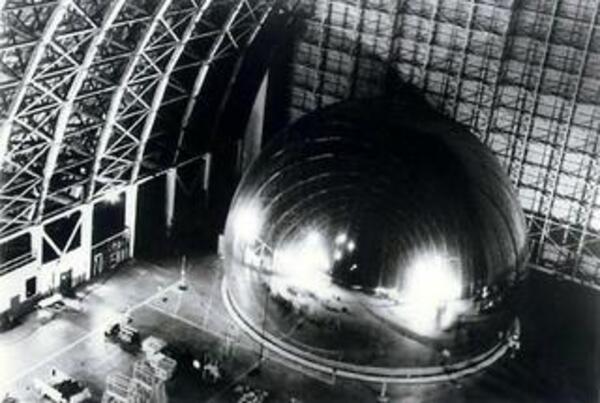
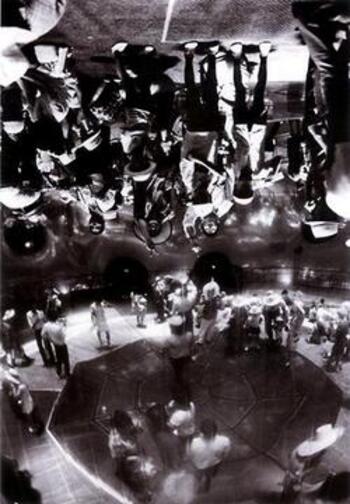
E.A.T. – Experiments in Art and Technology, «Pepsi Pavilion for the Expo '70», 1970
Spherical Mirror (model) | ©
A 90-Foot, 210 Degree Spherical Mirror made of Mylar, a full-scale Model of the Mirror for the PEPSI-COLA Pavilon. The Marine Corps Air Station, Santa Ana. September 30, 7-11 pm. R.S.V.P. 213 467 2123.
- E.A.T. – Experiments in Art and Technology
«Pepsi Pavilion for the Expo '70» Photograph: Fujiko Nakaya | ©
«The ‹Pepsi Pavilion› was first an experiment in collaboration and interaction between the artists and the engineers, exploring systems of feedback between aesthetic and technical choices, and the humanization of technological systems. Klüver‘s ambition was to create a laboratory environment, encouraging ‹live programming› that offered opportunity for experimentation, rather than resort to fixed or ‹dead programming› as he called it, typical of most exposition pavilions. […] The Pavilion‘s interior dome–immersing viewers in three-dimensional real images generated by mirror reflections, as well as spatialized electronic music–invited the spectator to individually and collectively participate in the experience rather than view the work as a fixed narrative of pre-programmed events. The Pavilion gave visitors the liberty of shaping their own reality from the materials, processes, and structures set in motion by its creators.»
source: http://www.mediaartnet.org/works/pepsi-pavillon/?desc=full
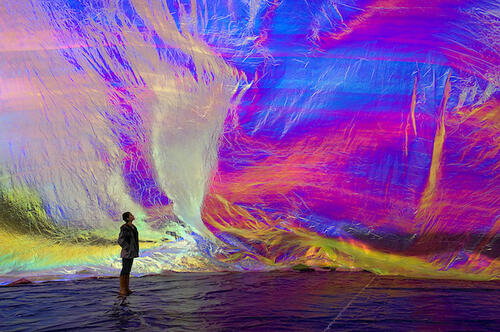
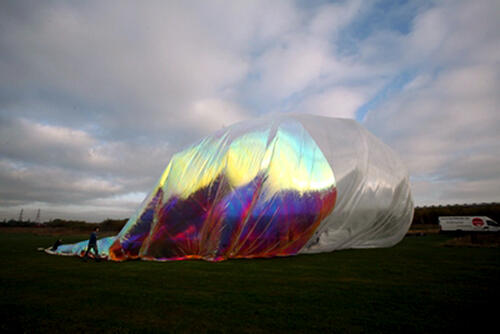
A synthetic sunlit magical environment, Tomas Saraceno's Poetic Cosmos of the Breath was an experimental solar dome . It was launched at dawn September 22nd 2007 at Gunpowder Park, Essex, UK. “A report on the morning appeared on Michaela Crimmin's RSA's Art & Ecology blog: “On a recent Saturday morning I got up before dawn to go to Gunpowder Park to see the latest work by Argentinian artist Tomas Saraceno. … Trained as an architect, Saraceno’s work poses the idea of floating cities. At the invitation of Arts Catalyst he brought a giant inflatable to the early morning autumn mists of Essex. It lay there, a huge circle of sheeting on the ground, held down by sandbags. A small group of lucky, lucky people were there in the dew. Slowly we helped the giant fill with air and grow as the sun came up and saw it brought to life, the colours of the foil which forms part of the material spectacularly colourful as the sun reflected off it.
more inflatable image sections: Inflatable Spaces - Powered by Wind - Parasite Inflatables - Soap Experiences - When Nature Inflates - Environmental Blendings - Hardened Bubbles - Inflatable Sound - Interactive Inflatables - Inflatable Wearables - The Non Categorized Inflatables - Lighter than Air - NASA Inflatables - Leftover Inflatable Archive or go back to: Cocky Eek
– Cocky Eek - 30 Jan 2007
